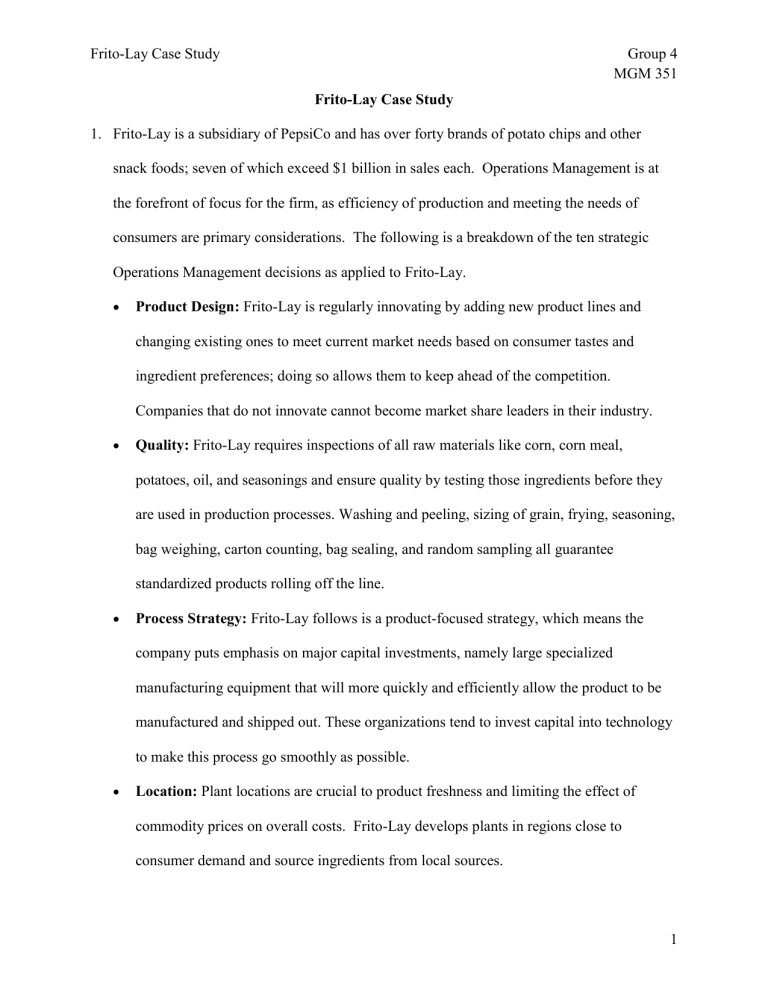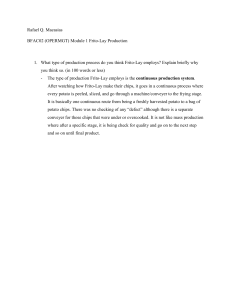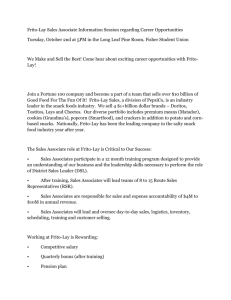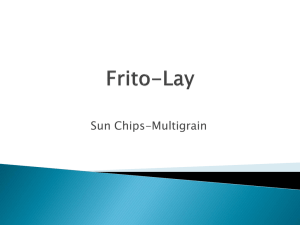
Frito-Lay Case Study Group 4 MGM 351 Frito-Lay Case Study 1. Frito-Lay is a subsidiary of PepsiCo and has over forty brands of potato chips and other snack foods; seven of which exceed $1 billion in sales each. Operations Management is at the forefront of focus for the firm, as efficiency of production and meeting the needs of consumers are primary considerations. The following is a breakdown of the ten strategic Operations Management decisions as applied to Frito-Lay. Product Design: Frito-Lay is regularly innovating by adding new product lines and changing existing ones to meet current market needs based on consumer tastes and ingredient preferences; doing so allows them to keep ahead of the competition. Companies that do not innovate cannot become market share leaders in their industry. Quality: Frito-Lay requires inspections of all raw materials like corn, corn meal, potatoes, oil, and seasonings and ensure quality by testing those ingredients before they are used in production processes. Washing and peeling, sizing of grain, frying, seasoning, bag weighing, carton counting, bag sealing, and random sampling all guarantee standardized products rolling off the line. Process Strategy: Frito-Lay follows is a product-focused strategy, which means the company puts emphasis on major capital investments, namely large specialized manufacturing equipment that will more quickly and efficiently allow the product to be manufactured and shipped out. These organizations tend to invest capital into technology to make this process go smoothly as possible. Location: Plant locations are crucial to product freshness and limiting the effect of commodity prices on overall costs. Frito-Lay develops plants in regions close to consumer demand and source ingredients from local sources. 1 Frito-Lay Case Study Group 4 MGM 351 Layout Strategy: Frito-Lay has developed a product-oriented layout. Raw potatoes get washed and peeled, sliced, cooked, seasoned, and bagged in a single assembly line in just a few hours. Even more interesting is that only two and a half days’ worth of inventory is kept in storage. Human Resources: Frito-Lay has one of the lowest personnel turnover rates in the industry. The company emphasizes paying good wages and benefits and puts concern for safety and treating all employees equally as priorities. Additionally, employees are put on clear job trajectories which encourage greater job satisfaction. Supply Chain Management: Frito-Lay takes their products from farm-fresh raw materials to in-store finished goods in a very short time span. This required them to establish some of their own farms and control transportation, including trucks, for raw materials, warehousing, distribution, and delivery. Inventory: Frito-Lay can incur a significant and unnecessary cost by holding inventory. Major ingredients at the plant are corn, potatoes, oil, and season. And because the inventory can turn easily, holding cost can be huge. This is a just in time inventory system. As raw materials, potatoes are delivered ten times a day and are even tracked by GPS to know where they are in transit. Scheduling: Frito-Lay makes an effort to schedule supply-chain employees based on total demand. Using historical product sales, new product introductions, production innovations and promotions, and dynamic local demand forecasts, final schedules are adjusted as needed. Maintenance: Frito-Lay ensures staff are available on every shift that are trained and equipped to minimize production delays if part of the system goes down for any reason. 2 Frito-Lay Case Study Group 4 MGM 351 If a machine breaks down in the Florida plant, every one percent of downtime is a loss of $200,000 - a crucial hit to the company. 2. The productivity of the production process can be determined by output over input. For example, input could be labor hours and output could be something in pound. However, if multifactor productivity comes into play, capital, labor, material, and energy are taken into consideration. 3. Where Frito-Lay’s focus is on the production of tangible goods in the form of snack foods, the Hard Rock Café’s focus is on the provision of exceptional customer service and a unique experience for guests at their restaurants and hotels. Design of goods and services: Hard Rock Café’s primary tangible product is food, however the company prides itself on the experiences it can provide guests by offering live music and music memorabilia, and the café itself serves as a tourist attraction. This is very different from the straightforward production that Frito-Lay deals with. Managing quality: Hard Rock Café modifies their menu based on regional fare as well as what foods are in season and available in the market the restaurant is serving, ensuring high-quality product. The evaluation of quality is conducted through surveys given directly to customers and high standards need to be reflected in those responses. FritoLay is able to choose locations based on consistency of product quality and availability. Process and capacity design: Hard Rock Café prides itself on its service – restaurants are designed in ways to ensure efficiency in the kitchen and dining rooms so guests are served their food quickly and correctly. Frito-Lay focuses more on efficiency of production and does not necessarily need to worry about how the facilities look to guests of the location. 3 Frito-Lay Case Study Group 4 MGM 351 Location: Hard Rock Cafes are located in tourist locations, and an emphasis is placed on finding locations of historic value to the brand’s image. Frito-Lay is able to place production facilities in areas that are cost-effective to their operations regardless of the significance of those locations. Layout: A kitchen layout is critical to efficient food preparation and that a bar is critical in many food establishments for profitability. The retail shop in the restaurant and its layout is also a critical ingredient for profit at Hard Rock. Frito-Lay needs only to concern itself with how the line can operate efficiently; it has a more limited scope in this regard. Human resources: Hard Rock Café looks for people who are passionate about music, love to serve, and can tell a story, but in the food service industry turnover can be very high and large fluctuations in customer bases can be seen seasonally. This prevents a similar approach to human resources like what is seen with Frito-Lay, which is able to emphasize good employee relations and low turnover. Supply-chain management: Hard Rock Café is able to determine how to alter its supply chain on a per-facility basis based on the needs of the facility and its employees. FritoLay can ultimately manage more of their supply chain because they manage more of the chain and do not depend on third parties to supply a significant amount of product or support. Inventory Management: Hard Rock Café applies inventory management decisions through the use of inventory management software and uses demand fluctuations and historical records to predict changes needed in the inventory. The inventory is then 4 Frito-Lay Case Study Group 4 MGM 351 adjusted accordingly. Frito-Lay focuses rapid turnaround for its inventory to guarantee freshness of their product. Scheduling. Hard Rock Café makes decisions in scheduling by evaluating current operations effectiveness. The schedules must satisfy capacity requirements. Also, operations managers disseminate planned schedules to staff and use their feedback to make adjustments. The adjusted schedules are then applied to ensure flexibility and resilience of the business. Frito-Lay is focused on schedule consistency and clarity to maintain steady 24-hour operations. Maintenance: Maintenance decisions at Hard Rock Café are made and applied based on a comparative evaluation of assets and the firm’s standards. The company has standards on how much equipment wear and tear is allowed before the equipment needs repair or replacement, they catalog every piece of memorabilia that is in the locations. Frito-Lay has a much higher price to pay in terms of downtime should a piece of their operation fail to operate correctly, so they keep maintenance personnel on all shifts to respond as needed. 5






